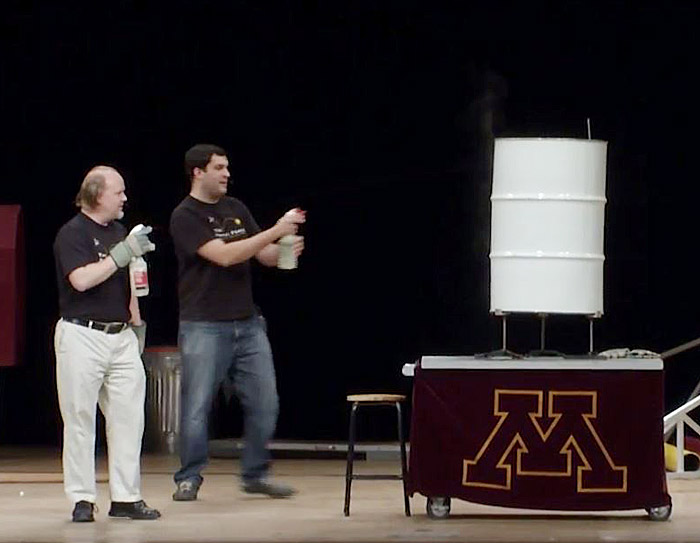What Happens
In this demo, a large 55 gallon is filled partly with water and heated. The barrel is sealed and then members of the Force spray it with water. After a few minutes, the barrel suddenly collapses, making a loud noise.
How it Happens
This is the finale in a series of demonstrations designed to demonstrate the incredible pressure of the atmosphere. The barrel has about 3 liters of water in it, which has been boiling for a few minutes. This boiling causes the air inside to be forced out and replaced with steam. There will be steam coming out the opening at the top as it comes out on stage which shows most, if not all, of the air has been forced out of the barrel.
When the demonstrator removes the heat and caps the opening, it begins the process of cooling the barrel and its contents. This causes the steam in the barrel to condense into water, thus significantly reducing the volume of the contents. When this takes place, the pressure is lowered inside the barrel, and now the atmospheric pressure outside the barrel will be much greater than the pressure inside. It turns out that the barrel can withstand about 9 pounds per square inch difference, but beyond that it is simply too much pressure for the metal to withstand and it collapses.
Because the barrel is round and reinforced with ribs along its outside, it builds up quite a lot of tension and when some imperfection in the roundness occurs, the barrel collapses in a hurry.
There are several tons of force exerted by the pressure on the barrel that act to crush it, and the integrity of the steel is overcome . It is an implosion rather than an explosion, and the sound is quite distinctive.
Vocabulary
air pressure: Pressure exerted by the weight of air on an object in that air. There will be discussion about this when we describe the reason for the plunger being held onto a piece of clear plexiglass, when the rubber playground softball base is used to lift a chair using air pressure, when we use the Magdeburg disks being held together by air pressure and when we crush a 55-gallon drum using air pressure.
atmospheric pressure: This is also the pressure caused by air, but usually thought of as the normal value or standard value of 14.7 pounds per square inch. The atmospheric pressure at the place where we are on the face of the earth is usually less than this because we are above sea level, and hence have less "weight" pushing down on us. Again, used with the same activities as air pressure.
high pressure: A space where the pressure is more pounds per square inch than a neighboring space. We will be discussing the idea that the pressure is higher outside the 55-gallon drum than inside the drum.
low pressure: A space where the pressure is fewer pounds per square inch than a neighboring space. We will use this term along with the term high pressure in order to describe the resulting force that will tend to push something one way or the other.
volume: In the context of this show, it can be thought of as space defined by an enclosure of some kind. It is 3 dimensional much like a box, but not necessarily having square corners. One of the volumes we will be working with is in the form of a cylinder-the 55 gallon drum. In the chair lift, we will have a volume of irregular shape, we will call it a cavity.
